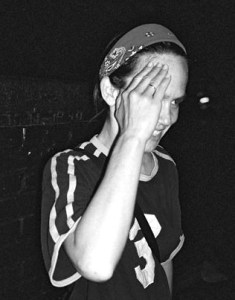
|
|
| HOME | ART | ARTISTS | EXILE |
Miriam Montrémy
The “Paradox and Atelier” quickly followed, but nothing matched the early promise of “Accumulation and Loss,” and when mediocre reviews were replaced by utter silence, Montrémy retreated to a maid’s room on the top floor of a ramshackle building on rue Piat. There, having resigned herself never to publish again, she began to make substantial strides in her craft. Today’s readers owe a considerable debt to videomaker and neighbor Geneviève de Parnier for combing through the garbage to rescue a work in progress after Montrémy’s sudden death, then publishing it online at considerable personal cost. Despite efforts at censorship, the “Green Notebook” * as it quickly became known, spread through the blogosphere as quickly as authorities attempted to suppress it. Fragments appeared as worms on official sites, and were transformed into headbanging anthems of protest in illegal clubs, “nomegestrol, nomegestrol plus 462 / prenez une carrote et baisez-vous.” In fact, the notebook reveals not a casual dissident, but an artist at the height of her powers grappling yet again with accumulation and loss. First tabulating words counts, then chronicling the discovery of a threat to her health, the diary is transformed from the simple record of a working writer into an oeuvre d’art by revisions made before her death in which she excised the superfluous and indulgent, and reduced “character” and “plot” to a few scattered notes, and emotion to the signifiers of punctuation which underline the vain excesses of modern prose. Nevertheless, in the minimalism which increasingly characterized what became the B-Ville group, along with an Orwellian repetition, she found the tools to induce the state of obsession that censors once rejected along with her supposed “immoral degradation of alternative kingdoms.” In retrospect, the incantatory power of this meta-work actually cements a critique of spiritual and physical reductionism that the Pornography Act was intended to prevent. Readers should embrace Montrémy, not for her victimization at the hands of overzealous censors, or extravagant death, but her persistence, modesty, and perpetual engagement with the “objectivity” of our lives that continues to inspire generations of artists. *Named for the color of the notebook in which she wrote, this is also known as the Asshole Diary from a quote excised from her Dec. 12 entry, “This should be called the Asshole Diary, or the Diary of All My Holes.” |
 |
 Born in Burkina Faso, Miriam Montrémy returned to B-Ville with her missionary parents when the last inhabitant ceded their village near Koudougou to the invading sands. A companion at Lycée Tristan Tzara said she was haunted by the event of accumulation and loss, which became the title of her first novel published ten years later, stunning critics with its acerbic wit and grieving prose.
Born in Burkina Faso, Miriam Montrémy returned to B-Ville with her missionary parents when the last inhabitant ceded their village near Koudougou to the invading sands. A companion at Lycée Tristan Tzara said she was haunted by the event of accumulation and loss, which became the title of her first novel published ten years later, stunning critics with its acerbic wit and grieving prose.